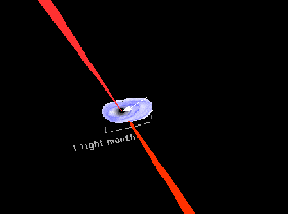The Swift project will study gamma ray bursts given off by deep space objects like this black hole.
Click on image for full size
Courtesy of NASA
NASA Reveals Two New Missions
News story originally written on October 28, 1999
NASA has two new missions! The Swift and FAME projects were chosen to be part of the MIDEX program. Swift will launch in 2003 and FAME will launch in 2004.
The Swift spacecraft will use three different telescopes to study gamma ray bursts. These bursts are given off by deep space objects like black holes! Scientists will use the data to learn about the edges of the Universe.
FAME stands for the Full-sky Astrometric Mapping Explorer. It will find the brightness and location of millions of stars in our galaxy! Scientists will know more about the stars than ever before!
You might also be interested in:

Imagine you found a pair of special glasses that not only gave you telescopic vision but gave you the ability to see all forms of radiant energy. The universe in visible light contains all the familiar
...more
It was another exciting and frustrating year for the space science program. It seemed that every step forward led to one backwards. Either way, NASA led the way to a great century of discovery. Unfortunately,
...more
The Space Shuttle Discovery lifted off from Kennedy Space Center on October 29th at 2:19 p.m. EST. The sky was clear and the weather was great. This was the America's 123rd manned space mission. A huge
...more
Scientists found a satellite orbiting the asteroid, Eugenia. This is the second one ever! A special telescope allows scientists to look through Earth's atmosphere. The first satellite found was Dactyl.
...more
The United States wants Russia to put the service module in orbit! The module is part of the International Space Station. It was supposed to be in space over 2 years ago. Russia just sent supplies to the
...more
A coronal mass ejection (CME) happened on the Sun last month. The material that was thrown out from this explosion passed the ACE spacecraft. ACE measured some exciting things as the CME material passed
...more
Trees and plants are a very important part of this Earth. Trees and plants are nature's air conditioning because they help keep our Earth cool. On a summer day, walking bare-foot on the sidewalk burns,
...more















